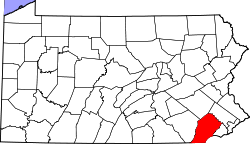This article needs additional citations for verification .(March 2022) |
Ludwigs Corner, Pennsylvania | |
|---|---|
 Ludwigs Corner lies the intersection of PA Route 100 and PA Route 401 in Chester County, Pennsylvania. | |
Location of Ludwigs Corner in Pennsylvania | |
| Coordinates: 40°06′56″N75°41′38″W / 40.11556°N 75.69389°W | |
| Country | United States |
| State | Pennsylvania |
| County | Chester |
| Township | West Vincent |
| Elevation | 627 ft (191 m) |
| Time zone | UTC-5 (EST) |
| • Summer (DST) | UTC-4 (EDT) |
| Area code | 610 |
Ludwigs Corner is an unincorporated village located in West Vincent Township, Pennsylvania, United States. It is four miles north of Eagle.


